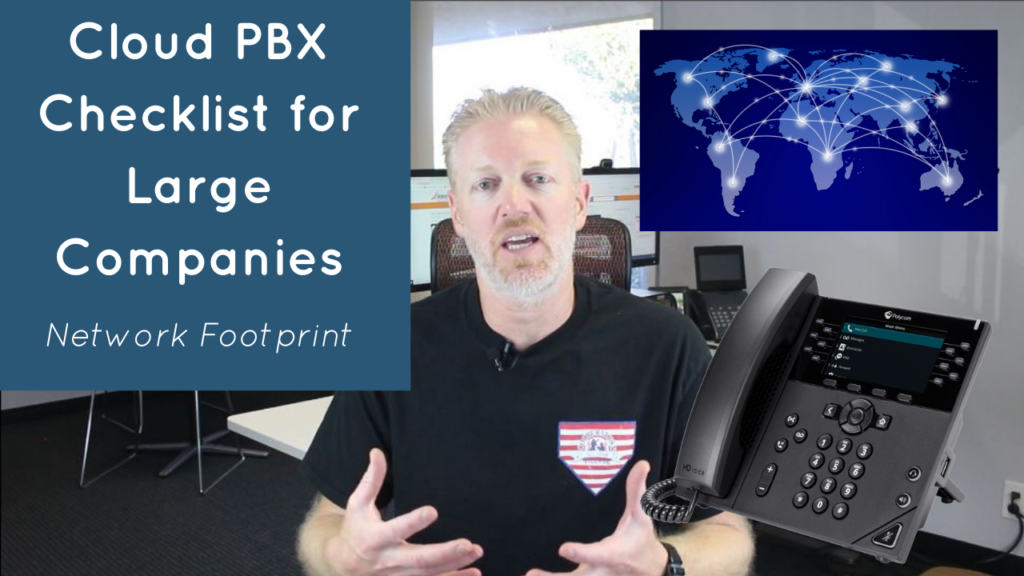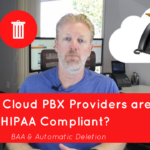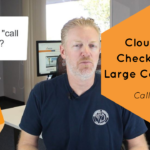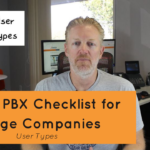This is the first installment of the Cloud PBX Checklist for Large Companies, and today Mike is talking Network Footprint.
In the video below, Mike tells you the questions you need to ask internally (and of service providers), about “network footprint,” if your company has more than 100 employees and you’re shopping for a new phone system.
Want Mike’s recommendations on the best cloud PBX vendors for your large company? Click the button below to ask him today.

About Mike

Mike Smith is the Founder and President of AeroCom and has been helping companies with telecom and cloud services since 1999. He has been the recipient of numerous business telecommunications industry awards, including being recognized as one of the top 40 business people in Orange County, CA., under 40 years old. You can also hear him as the host of the popular Information Technology podcast, ITsmiths with Mike Smith. Follow Mike on YouTube, LinkedIn, Reddit and SpiceWorks.
Transcript
Your company is medium-sized, meaning you have about 100 employees or more, maybe up to around 5,000 employees and you’re looking for a new phone system.
Well, I wanted to make a video series on a checklist for companies like yourself. I’m a broker for all the major service providers out there. And definitely, if you’re shopping for a new phone system for a cloud PBX service, you definitely want to have a checklist of things you should be asking your company internally, as well as things you should be asking the service providers that will really make a difference.
So this video, in particular, I’m focusing on network footprint. You should be thinking about network footprint.
Before we get too far ahead…
But before I get started, really quick, if you want to shortcut and just know which service provider should we be quoting for our company for a new phone system, don’t Google it. You can watch this video… There’s a lot of good information on there in terms of the whole series that I’m going to do on the same topic. But if you want a shortcut, just reach out and contact me, via email or phone (714.593.0011), for more information on that at the end of the video.
Data Centers
All right. So network footprint.
Why is that important when you’re shopping for cloud PBX service providers? Well, obviously, some cloud PBX service providers have a different network footprint than others, and you want to make sure before you start quoting service providers, that the providers you’re quoting have a network footprint that matches your company. So what you want to do is make sure you’re aware of where your users are sitting. So are they sitting in one city in the United States or are they spread all throughout the United States and maybe in different countries as well? You want to know where are our users at.
And the service providers that you’re quoting you want to make sure that they have data centers that are somewhat nearby those clusters of users, and then to take it a step further, you not only want to make sure that that service provider has data centers nearby, you want to make sure that they have local calling access in those data centers nearby.
Local PSTN Access
And what I mean by that is that say you have most of your users in the United States, and then you also have some users in the UK and you also have some in Australia and you also have some in Africa. Well, you want to make sure that the service providers you’re quoting not only have data centers in those other countries, but you also want to make sure that if they make a phone call from that country, it hits the PSTN within that country, meaning the call doesn’t have to travel all the way on the internet all the way back to the United States to get dial tone.
Because when that happens, you really increase your likelihood of bad call quality. Obviously, the latency between Australia and the United States would be huge. If your call has to go all the way back to the United States to pull dial tone. So you really have to be careful of that because sometimes service providers will say, oh yeah, we have a data center in Australia, but does that data center have dial tone? Meaning that is your call going to be getting dial tone locally right there in Australia? Or is that call going to have to be pulling dial tone from the United States? Sometimes the sales rep you’re talking to has not been in the industry a long time and so they don’t even know the answer to that question and you know sales reps, they’ll just say yes. So you want to make sure you ask that question.
Phone Number Portability
Another thing with network footprint that you want to know is does your company need to port your existing phone numbers from all the locations that you’re currently in? So some companies say yes, some companies don’t care. We don’t need a local phone number for our Australia customers or Australia users or our China users or things like that. So you want to make sure you ask yourself do we want to port those phone numbers? Is that really important to us? And then the service providers you’re quoting, can they port numbers within that country? Sometimes they can service the country with new numbers, but they can’t port existing phone numbers from that country. That’s why it’s important to know that upfront and to ask the key stakeholders within your company if that’s important because that will be a big deal down the road if you don’t clarify that up front. Last but not least, in terms of network footprint, there are certain countries that no matter what service provider you use, they’re not going to be able to port the phone numbers within that country.
For instance, China, or if you’re looking to port phone numbers in India, no can do. No matter what service provider you use, they’re not going to be able to port phone numbers within that country. So kind just know that there are some that kind of overlap that all the providers are the same on and there are other countries as well that providers are different. Some can port numbers, some can’t. So you want to ask those questions upfront.
Want Mike to give you a custom checklist?
I hope that helps. That’s a little bit in terms of your checklist for buying a new phone system for your mid-sized company to large-sized company. That’s one of the things you definitely want to look at. Check out my other videos as well that I’m going to make in this video series about all types of different things so you can really build that checklist.
But again, if you want to skip the checklist, if you don’t want to do all the work, or if you just want some help, reach out and contact me via email or phone (714.593.0011). Within a few questions, I can tell you which service providers you should be quoting and I can introduce you to those service providers and oversee the quoting process to make sure that it goes well, that you get introduced to the right people within those companies, and that they give you their lowest pricing possible. I’m a broker for all the major cloud PBX service providers and I’ve been doing this for 18 years. I know it inside and out.
Don’t Google it
And I can tell you if you just start Googling, you’re going to probably end up with the wrong one or a provider with a really bad reputation and you’re going to be sorry that you just didn’t reach out and contact me. And the nice thing is I don’t charge you anything for helping you. If you find something that you like, the service provider actually pays me my broker fee. So you don’t have to pay me at all. There’s no excuse not to at least reach out and ask me for my advice. So I hope the video was helpful. If so, again, watch the rest of the series and I’ll look forward to catching you on the next one. Don’t forget to hit the like button and subscribe to the channel.







